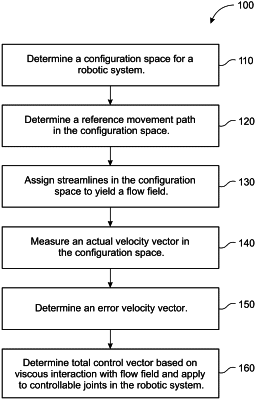| CPC B25J 9/1664 (2013.01) [B25J 9/1633 (2013.01); B25J 9/1651 (2013.01); B25J 9/1653 (2013.01); B25J 9/0006 (2013.01)] | 14 Claims |

|
1. A control method for generating a desired movement in a robotic system including a plurality of controllable joints and a controller, the control method comprising:
determining a configuration space for the robotic system, the configuration space including dimensionality equal to a number of the plurality of controllable joints;
determining, at the controller, a reference movement path within the configuration space;
assigning a plurality of streamlines in the configuration space to yield a flow field, each of the plurality of streamlines converging to the reference movement path and comprising a velocity magnitude;
measuring an actual velocity vector in the configuration space based on a plurality of velocity components corresponding to the plurality of controllable joints;
determining an error velocity vector based on a difference between the actual velocity vector and selected streamlines in the plurality of streamlines, the selected streamlines having a corresponding location in the configuration space to the actual velocity vector; and
applying a total control vector at the plurality of controllable joints, by the controller, based on the error velocity vector,
wherein applying the total control vector further comprises:
receiving, at the controller, at least one drag coefficient;
determining the total control vector based on a product of the at least one drag coefficient and the error velocity vector; and
applying torque or force at each joint of the plurality of controllable joints based on the total control vector.
|